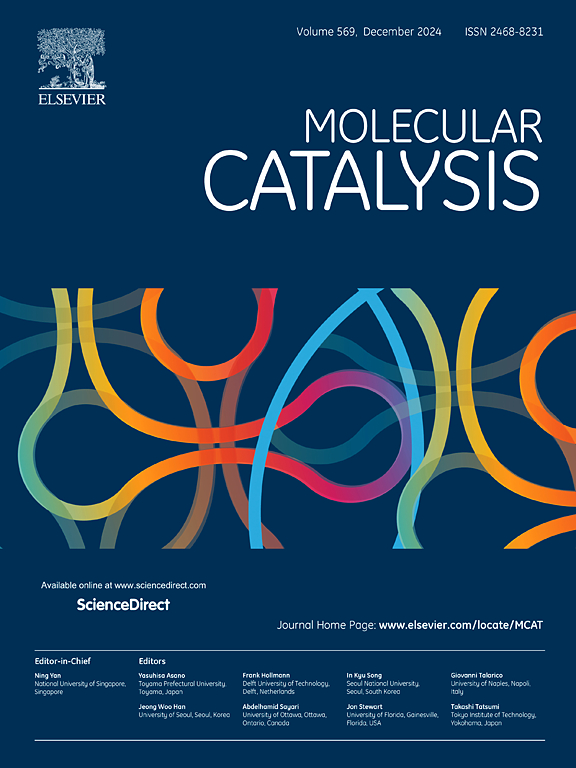cu基mof催化甘油选择性氧化制乳酸
IF 4.9
2区 化学
Q2 CHEMISTRY, PHYSICAL
引用次数: 0
摘要
研究人员合成了四种铜基mof (Cu-MOF、Cu-MOF-74、Cu-PTA-MOF和NH2-Cu-MOF),并首次将其用于甘油选择性催化氧化制乳酸。采用XRD、SEM、TEM和XPS对催化剂的晶相、形貌、晶体结构和表面元素的化学状态进行了表征。结果表明,cu基mof的活性位点均为Cu2+。Cu-MOF具有最大的比表面积和最小的晶格间距。由此可见,Cu-MOF具有最活跃的催化位点,促进电荷转移,增加电子迁移率,有效提高了甘油吸附能力。球状形貌的Cu-MOF具有最强的催化能力。甘油转化率高达97.15%,乳酸选择性为82.02%。利用密度泛函理论(DFT)研究了cu基mof表面对甘油的吸附性能。结果表明,Cu-MOF具有最大的吸附能,有利于甘油在其表面成键。循环实验表明,Cu-MOF在催化过程中表现出良好的稳定性,通过XRD和XPS观察到反应后Cu-MOF的晶相和价态没有明显变化。本文章由计算机程序翻译,如有差异,请以英文原文为准。

Selective oxidation of glycerol to lactic acid catalyzed by Cu-based MOFs
The researchers synthesized four copper-based MOFs (Cu-MOF, Cu-MOF-74, Cu-PTA-MOF, and NH2-Cu-MOF) and used them for the first time in the selective catalytic oxidation of glycerol to lactic acid. The crystal phase, morphology, crystal structure and chemical state of surface elements of the catalysts were characterized by XRD, SEM, TEM and XPS. The results show that the active sites of Cu-based MOFs are all Cu2+. Cu-MOF has the largest specific surface area and the smallest lattice spacing. From this, it can be seen that Cu-MOF has the most active catalytic sites, promotes charge transfer and increases electron mobility, effectively improving glycerol adsorption capacity. The Cu-MOF with spherical morphology has the strongest catalytic ability. Glycerol conversion is as high as 97.15 %, and the lactic acid selectivity is 82.02 %. The adsorption properties of glycerol on the surface of Cu-based MOFs were studied by density functional theory (DFT) calculations. The results show that Cu-MOF has the largest adsorption energy, which is favorable for the bonding of glycerol on its surface. Cycling experiments demonstrated that Cu-MOF showed good stability during the catalytic process and no significant changes in the crystalline phase and valence state of the reacted Cu-MOF were observed by XRD and XPS.
求助全文
通过发布文献求助,成功后即可免费获取论文全文。
去求助
来源期刊

Molecular Catalysis
Chemical Engineering-Process Chemistry and Technology
CiteScore
6.90
自引率
10.90%
发文量
700
审稿时长
40 days
期刊介绍:
Molecular Catalysis publishes full papers that are original, rigorous, and scholarly contributions examining the molecular and atomic aspects of catalytic activation and reaction mechanisms. The fields covered are:
Heterogeneous catalysis including immobilized molecular catalysts
Homogeneous catalysis including organocatalysis, organometallic catalysis and biocatalysis
Photo- and electrochemistry
Theoretical aspects of catalysis analyzed by computational methods
 求助内容:
求助内容: 应助结果提醒方式:
应助结果提醒方式:


